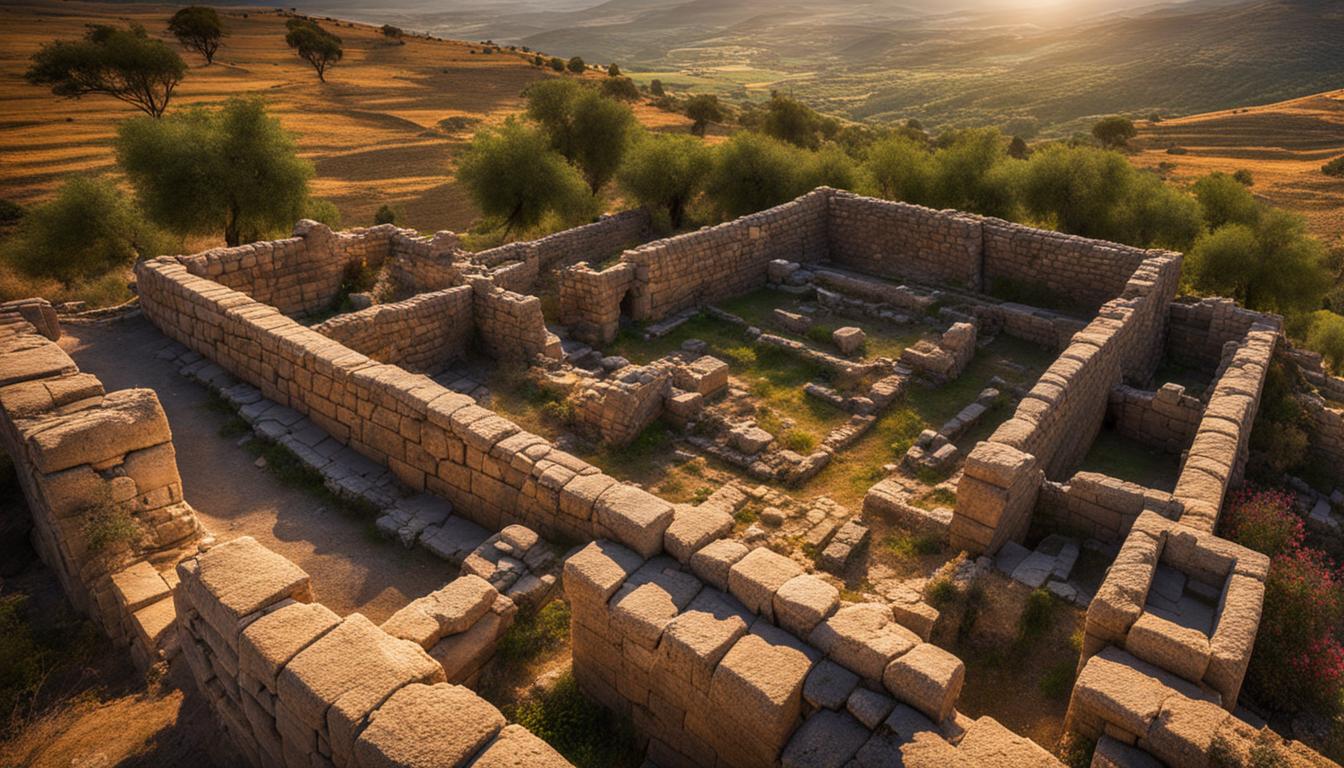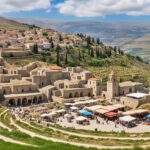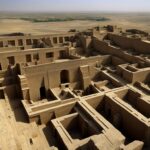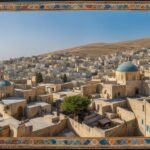Welcome to Samaria, an ancient city of immense historical significance. This archaeological site, once the biblical kingdom of Israel and the capital of the Israelite kingdom, is a treasure trove of ancient ruins and cultural heritage. From its biblical references to its architectural marvels, Samaria offers a captivating journey into the past.
In biblical times, Samaria was not only an Israelite capital but also a religious center. It witnessed major events that have shaped its history, including the confrontation between the prophets of Baal and Elijah, and the eventual downfall of the Israelite kingdom. The city itself boasted grand palaces, temples, and impressive infrastructure, showcasing the wealth and power of its ruling elite.
Today, Samaria stands as an important archaeological site that attracts visitors from around the world. Excavations have unearthed various structures, providing insights into the daily life and architecture of biblical times. Preserving and exploring this cultural legacy is crucial to understanding the historical significance of Samaria.
Key Takeaways:
- Samaria was the capital of the biblical kingdom of Israel and a religious center.
- Notable biblical figures linked to Samaria include King Omri, Ahab, Elijah, and Elisha.
- The city boasted impressive architecture and infrastructure in biblical times.
- Major biblical events, such as the confrontation between the prophets of Baal and Elijah, impacted Samaria’s history.
- Samaria is now an important archaeological site, showcasing ancient ruins and cultural heritage.
The Biblical Importance of Samaria
In the Bible, Samaria holds great significance as the capital of the kingdom of Israel and the setting for numerous biblical events. It was home to notable figures such as King Omri, Ahab, Elijah, and Elisha, who played pivotal roles in shaping the nation’s history.
One of the most well-known events that took place in Samaria was the confrontation between the prophets of Baal and the prophet Elijah. This dramatic encounter showcased the power of the Israelite God and led to a religious and political shift in the kingdom.
Additionally, Samaria’s downfall came when it was besieged and ultimately destroyed by the Assyrians in 722 BC. This event marked the end of the Israelite kingdom and the beginning of the dispersion of the ten northern tribes, greatly influencing the region’s future.
“Samaria’s biblical importance is undeniable. It is a place where significant figures walked and where pivotal events unfolded. Its historical and religious significance has fascinated scholars and believers alike for centuries.” – Dr. Sarah Thompson, Biblical Studies Expert
| Biblical Figures | Biblical Events |
|---|---|
| King Omri | Established Samaria as the capital of the kingdom of Israel |
| Ahab | Ruled during a time of religious conflict and significant political events |
| Elijah | Confronted the prophets of Baal and performed miracles in Samaria |
| Elisha | Continued the prophetic legacy in Samaria and performed miracles |
The biblical importance of Samaria cannot be overlooked. It serves as a testament to the rich historical and religious heritage of the region, captivating the hearts and minds of visitors from around the world.
The Appearance and Function of Samaria in Biblical Times
In biblical times, Samaria was a city that showcased grandeur and power. Built on a hill and surrounded by protective walls, it stood as a symbol of the Israelite kingdom’s political and administrative center. The city boasted impressive architecture and infrastructure, including palaces, temples, and other magnificent structures.
Samaria’s appearance was awe-inspiring, with its towering palaces serving as a testament to the wealth and opulence of the ruling elite. The temples were intricately designed, reflecting the city’s religious significance as a center of worship and religious activity. The streets were bustling with daily life, as merchants traded goods and residents went about their daily routines.
The function of Samaria in biblical times was multidimensional. As the capital of the kingdom of Israel, it served as the seat of power for the Israelite kings. It was a hub of political and administrative activities, with the ruling elite making important decisions that shaped the destiny of the kingdom. Additionally, Samaria was a center of religious pilgrimage, drawing worshippers from near and far to its temples and holy sites.
| Key Features of Samaria in Biblical Times | Function |
|---|---|
| Impressive architecture and infrastructure | Showcasing the wealth and power of the ruling elite |
| Towering palaces | Symbolizing the grandeur of the city |
| Intricately designed temples | Signifying Samaria’s religious importance |
| Bustling streets | Reflecting the daily life of the city’s inhabitants |
| Political and administrative center | Seat of power for the Israelite kingdom |
| Religious pilgrimage site | Attracting worshippers from far and wide |
“Samaria stood as a beacon of power and religious significance in biblical times. Its impressive architecture and grand structures showcased the wealth and opulence of the ruling elite. As the political and administrative center of the Israelite kingdom, it played a crucial role in shaping the destiny of the nation. The temples and holy sites in Samaria attracted worshippers from all corners, making it a center of religious pilgrimage.”
The Significance of Samaria’s Architecture
The architecture of Samaria in biblical times was not only visually stunning but also held deep symbolic meaning. The towering palaces and intricately designed temples were a testament to the power and influence of the ruling elite. They showcased the city’s prominence as the capital of the Israelite kingdom and exemplified the wealth and opulence of the royal court.
The architecture also played a crucial role in religious practices. The temples in Samaria served as places of worship and offerings, where the Israelites would connect with their god and seek divine guidance. The palaces, on the other hand, served as the dwelling places of the king and his court, providing royal comfort and a representation of the ruler’s authority.
Today, the remnants of Samaria’s architecture serve as a window into the past, allowing us to appreciate the craftsmanship and creativity of biblical times. The grandeur of the palaces and temples, even in their ruined state, continues to captivate visitors and scholars alike, offering a glimpse into the rich cultural heritage of Samaria.

The City’s Daily Life in Biblical Times
Samaria’s streets were a bustling hub of activity in biblical times. The city was teeming with merchants trading goods, residents going about their daily routines, and visitors from neighboring regions. The markets were vibrant, offering a wide range of products and commodities.
The daily life of the city’s inhabitants revolved around various activities, including tending to agricultural lands, engaging in trade and commerce, and participating in religious rituals. The city’s strategic location and its role as a cultural and religious center made it a melting pot of diverse influences.
Through the archaeological discoveries and the biblical references, we gain insights into the daily lives of the people who once walked the streets of Samaria. It paints a vivid picture of a thriving city that played a vital role in the history and culture of the region.
Major Biblical Events and Their Impact on Samaria’s History
In its long and storied history, Samaria has witnessed several major biblical events that have shaped its destiny. These events hold immense significance not only for the ancient city but also for the broader historical and religious contexts in which they occurred. Let’s explore some of these pivotal moments and their lasting impact.
The Confrontation Between the Prophets of Baal and Elijah
One of the most remarkable events in Samaria’s history was the dramatic confrontation between the prophets of Baal and the prophet Elijah. As recorded in the Bible, this face-off took place on Mount Carmel, near Samaria. Elijah, representing the worship of Yahweh, challenged the prophets of Baal, who served the pagan god, to a contest to prove the superiority of their respective deities.
“How long will you waver between two opinions? If the Lord is God, follow him; but if Baal is God, follow him.” – Elijah (1 Kings 18:21)
In a stunning display of divine intervention, Elijah’s prayers were answered, and the prophets of Baal were defeated. This event had a profound impact on the religious and political landscape of Samaria, as it marked a turning point in the Israelite kingdom’s allegiance to Yahweh and the decline of Baal worship.
The Siege and Destruction of Samaria by the Assyrians
Another significant event in Samaria’s history was the siege and destruction of the city by the Assyrians in 722 BC. The Assyrians, under the leadership of King Shalmaneser V and later King Sargon II, laid siege to Samaria for several years before finally breaching its defenses. The city was plundered, and its inhabitants were either killed, enslaved, or deported.
This event marked the end of the Israelite capital and the dispersion of the ten northern tribes of Israel, known as the Ten Lost Tribes. The destruction of Samaria had far-reaching consequences, reshaping the geopolitical landscape of the region and forever altering the course of Israelite history.
The Enduring Legacy of Major Biblical Events
The major biblical events that unfolded in Samaria continue to resonate in contemporary religious and historical narratives. They serve as reminders of the city’s rich heritage and the profound influence of religious clashes and political upheavals on the course of history.
Today, as we explore the ancient ruins and walk in the footsteps of these biblical figures, we are reminded of the timeless stories that have shaped our understanding of faith, power, and legacy. Samaria stands as a testament to the enduring impact of these events and the significance they hold for those who seek to connect with the tapestry of human history.
Table: Major Biblical Events and Their Impact on Samaria’s History
table {border-collapse: collapse; width: 100%;} th, td {border: 1px solid #ddd; padding: 8px; text-align: left;} th {background-color: #f2f2f2;}
| Event | Impact |
|---|---|
| The confrontation between the prophets of Baal and Elijah | Shift in religious allegiance and decline of Baal worship |
| The siege and destruction of Samaria by the Assyrians | End of Israelite capital and dispersion of the Ten Lost Tribes |
Samaria Today: An Archaeological Site and Cultural Heritage
Samaria is a captivating destination that offers visitors a unique opportunity to explore an ancient archaeological site and delve into its rich cultural heritage. The city’s historical significance and biblical references make it an intriguing place to visit, attracting tourists from around the world.
The archaeological site of Samaria is a treasure trove of ancient ruins, providing a glimpse into the daily life and architecture of biblical times. Excavations have revealed impressive structures such as palaces, temples, and residential buildings, showcasing the grandeur of the city in its prime. Walking through the remnants of these structures, visitors can imagine the bustling streets and thriving community that once inhabited Samaria.
“Samaria stands as an important archaeological site, showcasing the ancient ruins of the city.”
To further enhance the visitor experience, guided tours and educational displays are available, offering a deeper understanding of Samaria’s history and significance. These resources provide valuable insights into the city’s past, allowing visitors to immerse themselves in the rich cultural tapestry of Samaria.
| Archaeological Site Features | Visitors’ Experience |
|---|---|
| Magnificent palaces and temples | Visitors can explore the majestic structures, marveling at their architectural splendor. |
| Residential buildings | Insight into the daily life and living conditions of the ancient inhabitants of Samaria. |
| Guided tours | Expert guides provide an informative journey through Samaria’s history and significance. |
| Educational displays | Visitors can learn about the cultural and historical context of Samaria’s ruins. |
Samaria’s cultural heritage is a testament to its enduring legacy. Efforts are made to preserve and protect the archaeological site, ensuring that future generations can continue to learn from and appreciate its historical significance. By promoting awareness and understanding of Samaria’s cultural heritage, we can ensure that this fascinating destination remains a testament to our shared human history.
Whether you are drawn to Samaria for its religious importance, historical curiosity, or simply to marvel at the ancient ruins, a visit to this archaeological site is sure to be a captivating experience. Explore the remnants of a bygone era, immerse yourself in history, and discover the cultural legacy of Samaria.

Exploring Samaria’s Ancient Ruins
Exploring Samaria’s ancient ruins is a captivating journey through time. The archaeological site offers visitors a glimpse into the grandeur of the city in biblical times. As you walk through the remnants of palaces, temples, and other structures, you can imagine the bustling streets and the daily life of the people who once inhabited this ancient city.
“Samaria is a place where history comes alive. The ruins bear witness to the rich cultural heritage and the historical significance of this biblical site,” says Dr. Sarah Thompson, an archaeologist specializing in ancient Israelite history.
The ruins of Samaria provide invaluable insights into the architecture and infrastructure of the city. The grandeur of the palaces and temples reflects the wealth and power of the ruling elite who once governed from this bustling metropolis. Walking through the ancient streets, you can admire the intricate details of the structures and marvel at the ingenuity of the ancient builders.
To enhance the visitor experience, the archaeological site offers guided tours led by knowledgeable experts who provide informative commentary on the history and significance of each structure. Interactive displays and exhibits further enrich the exploration, bringing ancient Samaria to life and deepening our understanding of the people who called this city home.

Archaeological Discoveries
The excavations at Samaria have yielded numerous fascinating archaeological discoveries. One notable finding is the Ivory House, a luxurious residence adorned with intricately carved ivory panels, highlighting the opulence of the city’s elite. Another significant discovery is the famous Samaria Ostraca, a collection of ancient Hebrew inscriptions that provide valuable insights into daily life and administrative matters.
As you explore the ancient ruins, you can witness the layers of history unfold before your eyes. From the remains of the Israelite capital to the later additions of Hellenistic and Roman structures, Samaria’s archaeological site tells a complex story of cultural integration and change over time.
| Structure | Description |
|---|---|
| Palace of Omri | A magnificent palace built by King Omri, the founder of Samaria. |
| Temple of Baal | A place of worship dedicated to the Canaanite god Baal, reflecting the religious diversity of the city. |
| Acropolis | A fortified upper city, featuring defensive walls and towers. |
| Residential Quarter | A residential area with well-preserved houses, offering insights into the daily life of Samaria’s inhabitants. |
Exploring Samaria’s ancient ruins is not only a journey through history but also an opportunity to connect with the cultural heritage of this incredible biblical site. By delving into the past, we gain a deeper appreciation for the rich tapestry of human civilization and the enduring legacy of ancient Samaria.
Preserving Samaria’s Cultural Legacy
As an ancient archaeological site of immense historical significance, preserving Samaria’s cultural legacy is of utmost importance. Efforts are being made to protect and conserve this unique site for future generations to learn from and appreciate.
The preservation of Samaria’s cultural heritage involves employing best practices in conservation and management. Experts in the field ensure that the site remains structurally stable and protected from environmental factors that could potentially damage the ancient ruins. Through meticulous maintenance and restoration, the architectural marvels of Samaria can continue to be admired and studied.
Furthermore, educational outreach programs are in place to promote awareness and appreciation of Samaria’s cultural significance. Guided tours and interactive displays provide visitors with a deeper understanding of the history and context surrounding the site. By engaging visitors in a meaningful way, these initiatives foster a sense of connection and appreciation for Samaria’s cultural legacy.
The Importance of Community Involvement
Preserving Samaria’s cultural legacy also relies on the active involvement of the local community and stakeholders. Collaborative efforts are made to raise awareness and instill a sense of pride among the residents living near the archaeological site. By involving the community in preservation projects and promoting cultural tourism, the legacy of Samaria becomes a shared responsibility.
Through such engagement, the local community becomes stewards of their own heritage, ensuring the long-term preservation and sustainability of Samaria. This collective effort strengthens the bonds between the site and the people, reinforcing the value of cultural preservation for future generations to come.
| Preservation Initiatives | Community Involvement |
|---|---|
| Conservation and management practices | Engaging local community |
| Maintenance and restoration of ancient ruins | Promoting cultural tourism |
| Educational outreach programs | Instilling a sense of pride |
Through these combined efforts, Samaria’s cultural legacy can be preserved and celebrated for generations to come. It serves as a testament to the rich history and significance of this ancient city, allowing visitors from around the world to continue to be captivated by its allure.
Samaria’s Religious Significance
Samaria holds immense religious significance, both in biblical times and in modern religious traditions. It is prominently mentioned in the Bible as a center of worship and religious activity, making it a place of great importance for believers and scholars alike. The city’s religious significance is rooted in its historical connection to various biblical figures and events, which have shaped its role as a spiritual center.
Throughout the Bible, Samaria is associated with notable figures such as King Omri, Ahab, Elijah, and Elisha. These individuals played significant roles in the religious narrative of Israel, contributing to the overall religious fabric of the region. Their teachings, miracles, and prophecies have left a lasting impression on the religious consciousness, with Samaria serving as the backdrop for many of these impactful moments.
“And Elijah came unto all the people, and said, How long halt ye between two opinions? if the LORD be God, follow him: but if Baal, then follow him. And the people answered him not a word.” – 1 Kings 18:21
Even today, Samaria remains a point of reference in various religious texts and traditions. Its historical significance continues to resonate with believers, making it a site of pilgrimage for those seeking to connect with the religious history of the region. The enduring religious significance of Samaria serves as a testament to its enduring legacy and the profound impact it has had on the faith of many.

| Religious Significance | Biblical References |
|---|---|
| Center of worship and religious activity | 1 Kings 16:23-34, 2 Kings 10:17 |
| Home to notable biblical figures | 1 Kings 16:23-34, 1 Kings 21:1-29, 2 Kings 1:1-18, 2 Kings 2:1-25 |
| Association with significant religious events | 1 Kings 18:20-46, 2 Kings 6:24-7:20 |
| Continued religious references and pilgrimage site | John 4:4-42 |
Conclusion
Samaria, with its cultural heritage and historical significance, offers a captivating glimpse into the past. This archaeological site showcases the ancient ruins of a city that was once the capital of the biblical kingdom of Israel and a religious center. Preserving and exploring Samaria allows us to connect with its rich history and appreciate its cultural legacy.
In biblical times, Samaria was not only a thriving city but also the home of notable biblical figures such as King Omri, Ahab, Elijah, and Elisha. It played a significant role in various major biblical events, including the confrontation between the prophets of Baal and Elijah and the downfall of the Israelite kingdom. These events have left a lasting impact on Samaria’s history.
The appearance and function of Samaria in biblical times were truly impressive. Its hilltop location, surrounded by a protective wall, showcased its grandeur. The city was adorned with palaces, temples, and other magnificent structures, serving as the political and administrative center of the Israelite kingdom and displaying the wealth and power of the ruling elite.
Today, Samaria stands as an important archaeological site, offering visitors the opportunity to explore its ancient ruins. Walk through the remnants of palaces, temples, and residential buildings, and envision the grandeur that once filled the city. Preserving this cultural legacy is of utmost importance, ensuring that future generations can appreciate and learn from Samaria’s historical significance.
FAQ
What is the historical significance of Samaria?
Samaria is an ancient city that served as the capital of the biblical kingdom of Israel and a religious center. Today, it stands as an archaeological site, showcasing ancient ruins that offer insights into its rich cultural heritage.
Who were some notable biblical figures associated with Samaria?
Samaria was home to notable biblical figures such as King Omri, Ahab, Elijah, and Elisha.
What major biblical events took place in Samaria?
Several major biblical events took place in Samaria, including the confrontation between the prophets of Baal and Elijah, as well as the siege and destruction of the city by the Assyrians in 722 BC.
What can be found at the archaeological site of Samaria?
The archaeological site of Samaria showcases various structures, including palaces, temples, and residential buildings, offering insights into the daily life and architecture of biblical times.
Can visitors explore the ancient ruins of Samaria?
Yes, visitors can explore the remnants of palaces, temples, and other structures, imagining the grandeur of the city in its prime. The archaeological site offers guided tours and educational displays to provide a deeper understanding of Samaria’s history and significance.
How is Samaria’s cultural legacy preserved?
Efforts are made to protect and conserve the archaeological site of Samaria, ensuring that future generations can continue to learn from and appreciate its historical significance. The site is managed by experts who employ best practices in conservation and educational outreach.
What is the religious significance of Samaria?
Samaria holds religious significance, both in biblical times and in modern religious traditions. It is mentioned in the Bible as a center of worship and religious activity.
What can I expect to experience when visiting Samaria?
When visiting Samaria, you can expect to explore the ancient ruins, learn about its historical and cultural significance, and connect with the rich history of the region.
Source Links
- https://lovingcrete.com/explore-the-stunning-samaria-gorge-a-nature-lovers-paradise/?amp=1
- https://visitcrete.com/a-dive-into-the-mystical-samaria-gorge/
- https://www.tripadvisor.com/AttractionProductReview-g189415-d21240392-Samaria_Gorge_Private_Tour_A_Luxury_Adventure_in_Chania_Southwest-Chania_Town_Chan.html







